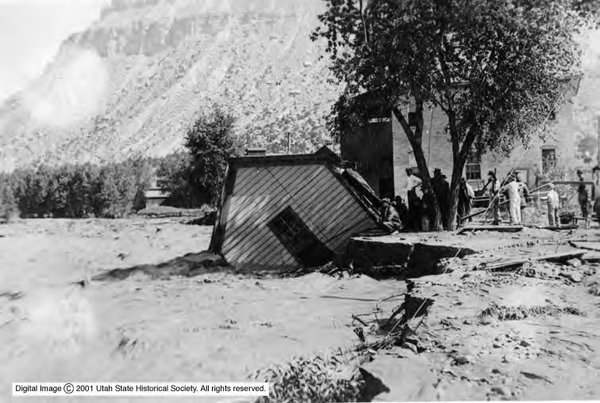Dublin Core
Title
Description
On June 24, 1917, the watchman at Mammoth Dam reported the reservoir’s water levels were holding steady. He left for lunch and returned to a dramatically different scene: the dam had given way! The waters released by the dam failure were catastropic, sweeping away properties and threatening the lives and livelihoods of Carbon County’s downstream communities. Makeshift conditions and inadequate operating procedures were just some of the all-too-common -- and preventable -- infrastructure issues that led to the Mammoth Dam failure.
The dam was initially built in 1902 on the Wasatch Plateau between Sanpete and Carbon Counties by the Price River Irrigation Company. By 1914, it was already up for renovations, but the reconstruction plans were never approved by the state engineer. Even still, the company was eager to store water and willing to overlook safety precautions in the process. With construction still underway, the company placed form boards around the top of the dam to accommodate increasing water levels. The rural, mostly immigrant population living in Carbon County communities downstream depended on Mammoth Dam, but had the most to lose by its failure.
When the watchman returned from his lunch on that June afternoon, he immediately called the dam caretaker for help. It took nearly two hours for the caretaker to arrive by horseback. Unfortunately, his desperate attempts to rescue the situation failed. The dam was entirely breached and a crushing force of millions of gallons of water was released downstream.
Thanks to early warning from the watchman, no lives were directly lost, although vulnerable residents of Scofield, Castle Gate, and Helper spent one scary night racing for higher ground ahead of the rushing waters. There were significant damages to property, crops, and business in the surrounding region, including nearly 30 miles of Denver & Rio Grande railroad track completely washed away.
Dams are central to Utah’s water infrastructure, but require maintenance. The shoddy upgrades to Mammoth Dam ultimately resulted in disaster and damage, and threatened the safety of Carbon County’s working class communities. It wasn’t until a series of nationwide dam failures in the 1970s that the federal government developed stronger dam safety regulations, hoping to protect those living downstream from aging infrastructure.
Creator
Source
_______________
See: Taylor Everett, Case Study: Mammoth Dam, 1917, “Lessons Learned from Dam Incidents and Failures,” Association of State Dam Safety Officials; Ronald G. Watt, A History of Carbon County,Salt Lake City, UT: Utah State Historical Society, 1997; “Utah Towns Endangered by Flood from a Dam,”Ogden Daily Standard, June 25, 1917; “Huge Property Loss Follows in Wake of Sweeping Waters,” Salt Lake Tribune, June 26, 1918; “Price River Valley Dam Crumbling: People Flee,” Salt Lake Tribune, June 25, 1917; HS Kleinschmidt, “Defiance of Statue and Engineering Law Wrecked Mammoth Dam,” Engineering News Record vol. 29, no. 2, July 12, 1917; “Large Law Violation in Mammoth Dam Construction,” Salt Lake Telegram, July 17, 1917; GF McGonagle, Report on the Failure of Mammoth Dam, July 7, 1917; Nathaniel Gee, “The Impact of Dam Failures on the Development of Dam Safety Legislation and Policy in the 1970s,” Association of State Dam Safety Officials; Taliesin Whimpey Evans, Interview by Mathis and Richard Winn, Carbon County Oral History Project, date unknown, Marriott Library, University of Utah.

